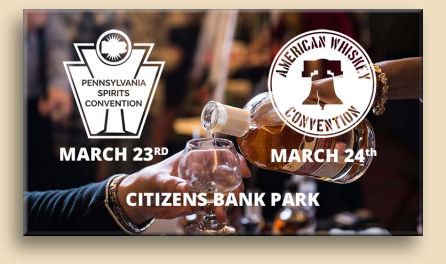American Whiskey
March
23 & 24, 2017
|
|
AS
IT IS with many of the consumables we enjoy, when we sit down with a glass
of fine whiskey we seldom give much thought to the materials or the processes by
which it was made. Well, maybe we do more with whiskey than, say, orange juice,
because the marketers and brand-developers of whiskey have long gone to even
more lengths than the Florida Growers Association
to make us think about what goes into that glass. There’s
nothing new about that; the history of whiskey marketing is fraught with glowing
testimonials to the perfect water, the rich, golden grain, the time-honored
traditional methods used to distill.
Not
that long ago – since we’ve been writing these essays – there were really only a
handful of commercial whiskey distilleries and the source of the corn, wheat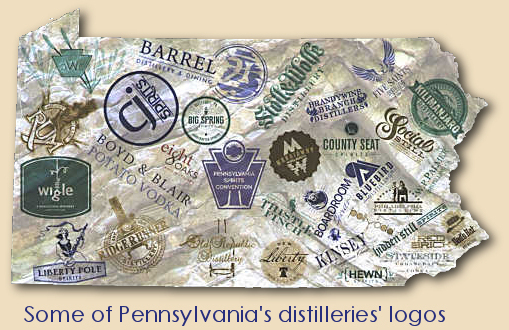 ,
rye, and barley they used was of little concern, save that it be dry, not moldy,
and inexpensive.
,
rye, and barley they used was of little concern, save that it be dry, not moldy,
and inexpensive.
Some mighty fine whiskey has been produced that way.
Mighty fine whiskey indeed.
Today we have nearly 1,500 small, local distilleries operating in the United States. Of course, each is looking for something that will make their product unique. And indeed one of the most important properties has been their connection to local grain farming.
It’s as if the distilling industry has come full circle -- from farmer/distillers in the 18th century, to massive alcohol factories sucking up #2 yellow dent corn from wherever they can get it, and back to artisan/craft distillers using grain grown in their local area, perhaps even by themselves or their immediate neighbors.
Of
course cereal grains, local or otherwise, also figure importantly in other
industries. Think fuel; cosmetics; paving bricks; certainly the whole baking
industry.
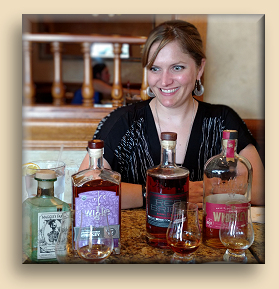
Even popcorn.
If Laura Fields, founder and chief racing engine of the Delaware Valley Fields Foundation, with her youth and her American apple pie good looks, had actually been an apple pie aficionado instead of a whiskey nerd, we probably wouldn’t be writing this page. And there probably would not have been the first Combined American Whiskey and Pennsylvania Spirits Conventions to write about.
Actually, this is the second American Whiskey Convention produced by the Foundation. Last year’s inaugural showing was very successful, enough so that Laura has added a second day, this one devoted to just spirits being distilled in the state of Pennsylvania. There are enough of them to warrant an entire event of their own. You see, the purpose of the Delaware Valley Fields Foundation is really agricultural. The aim is to educate the general public about issues facing small farming in the state. And a significant user of small farm-produced corn, wheat, and rye is (or should be, in her opinion) a healthy and growing distilling industry.
Especially rye. As you may already know from reading the American history articles here, It was in Pennsylvania that the production of farm-distilled whiskey began, and it became the major producer of commercial whiskey in the nation until Prohibition closed everything down. When the 18th Amendment was finally appealed, Kentucky had overtaken the state and what few Pennsylvania distilleries remained died out. By the middle of the last century there were none left.
Those times are a-changin'.
Seriously.
With a more enlightened legal environment to work in, Pennsylvania is experiencing a resurgence, and Laura sees that as being intimately connected with the welfare of local grain farmers. And that’s why we now have the Pennsylvania Spirits Convention and not the Pennsylvania Small Bakery Convention.
Then again, maybe she’s got something like that in mind for later!
Last
spring (2016) Laura contacted us through the Bourbon Enthusiast site and invited
us to get together next time we were in the Philadelphia area. We did meet her
there in July and she asked if we would like to present some historical
perspective as part of a panel she was putting together for the 2017 convention.
Other members of the panel were to be Lew Bryson, Jack Sullivan, and Sam Komlenic.
What an honor that turned out to be.
We first met Sam over twelve years ago on
his quest for information about the Dillinger distillery that once existed in
his home town; we’ve been co-exploring the ruins of the Pennsylvania distilling
industry ever since. As for Jack Sullivan and Lew Bryson, they’ve been
inspirational to our own understanding from the very beginning. Much of what
we’ve written was learned from reading articles by them.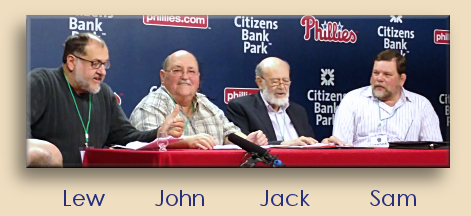
The panel discussion is being held this year in the press room at Citizens Bank Park, where the Philadelphia Phillies will be playing baseball this summer.
Our
panel discussion is divided into four parts, roughly based on the 17th/18th,
18th/19th, and 20th centuries, with Lew
speaking of the current trend of distillers. Our portion concerns the early
colonists and their relationship to distilling and to one another.
 The
gist of what we have to say is based on the article in this collection titled “Why
the Matron Saint of American Whiskey Should Be
Mary Hope”. Although “we” might have had that to say, only John actually
sits on the panel. Linda chooses to sit this one out in the audience.
The
gist of what we have to say is based on the article in this collection titled “Why
the Matron Saint of American Whiskey Should Be
Mary Hope”. Although “we” might have had that to say, only John actually
sits on the panel. Linda chooses to sit this one out in the audience.
The
convention floor itself, two flights up from the Phillies pressroom where the
panel is held, is awash in display areas. The site is the entire Hall of Fame
clubhouse and here are display booths representing nearly every craft-spirit
distillery in Pennsylvania. Not to mention grain growers, coopers, jewelry,
flasks, and even clothing. If you’ve ever visited a whiskey trade show you know
just what a fascinating adventure it is, what with tasting different products,
meeting the people who make them, and just visually soaking it all in. We had
the pleasure of sharing our experience with our nephews, Adam and Steven,
starting with a seminar devoted to the art of “nosing”, presented by
industry-leader Riannon Walsh.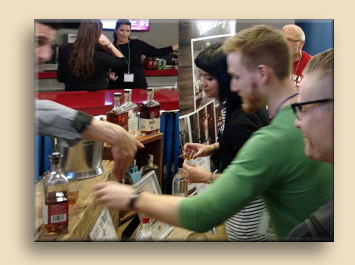
Tomorrow’s event, to which we are also invited guests, includes many of these same distillers, but much more. It is, in fact, the largest all-American whiskey event in the country. In attendance here are booths for every major distiller in the country. We ride the whirlwind of sights, sounds, smells (thank you, Riannon), and flavors, and stay until the last booth has been broken down and the final boxes of samples have been hand-trucked out the door.
The two conventions are only the opening barrage of what is called Philadelphia Spirits Week. Every evening until April 2nd spotlights a different Philadelphia venue, with appearances by American whiskey stars, fermentation classes, cocktail contests, and much more. The Delaware Valley Fields Foundation hosts the entire shebang.
Saturday morning we meet with Laura at The Dutch, a small, hip restaurant on South 4th Street. It’s just the three of us and we are especially honored to have this time with her.
That hour or so is probably the high point of the whole convention for us.

 |
|
|
Story and original photography copyright © 2017 by John F. Lipman. All rights reserved. |
|
